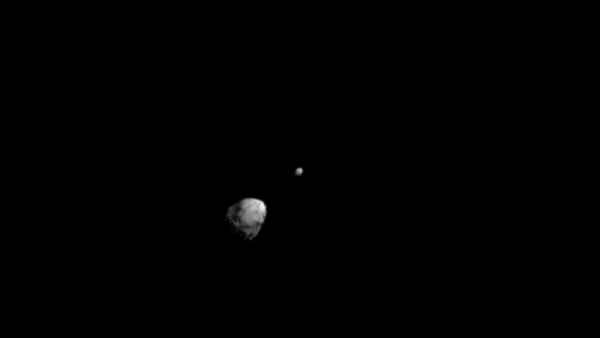Asteroid Redirects, Carl Sagan, and Underfunded Planetary Defense
Are asteroid deflection technologies dangerous? Necessary? Can humanity protect itself from both intentional and uncontrolled asteroid impacts?

Are asteroid deflection technologies dangerous? Are they necessary? If so, how can humanity protect itself from the two-sided coin of intentional and uncontrolled asteroid impacts? In this article we conclude that:
Asteroid redirect technology is a necessary yet potentially devastating capability. The technology will disseminate or be reproduced over the coming decades, and has the potential for nefarious use. NASA's Planetary Defense Coordination Office (PDCO) and its international partners are the most credible and best-positioned organization to mitigate asteroid threats - intentional or otherwise. PDCO funding amount and duration should be commensurate with these risks.
The road to reach these conclusions requires that we 1) understand the likelihoods and severities of asteroid impacts, 2) discuss the current state of the art in asteroid deflection technology, and 3) identify and internalize the inherent risks and rewards of asteroid redirect technology.
Off to the past... and the future!
1) A Certain Final Curtain?
There are few unmitigated disasters that are certain to occur.
A large asteroid impacting the Earth is one such disaster. Famously, a large city-, regional-, continental- or civilization-ending impact is a question of when, not if.
In response to this existential threat, the past 20 years have seen meaningful progress in Planetary Defense. In particular, the United States Congress has directed NASA to identify and catalog the vast dark armada of asteroids capable of impacting the Earth. The NASA Planetary Defense Coordination Office leads this mission. Their mission centers on the detection, orbit determination, and characterization of Near Earth Asteroids (NEAs) and serves as a coordination office for resulting decisions that could be made.
Enough apocalyptic films and discussions of global extinction events exist to make this point for me. Detecting, tracking, and characterizing asteroids is not enough. The ability to deflect asteroids is a necessary capability for long-term human survival.
2) The DART Mission
It is with these existential species-survival concerns that NASA funded Johns Hopkins University Applied Physics Lab (JHUAPL) to build and demonstrate asteroid deflection technology. In 2022 the Double Asteroid Redirection Test (DART) Mission demonstrated kinetic (i.e., impact) redirection of a small asteroid without the use of nuclear explosives.

The DART mission has struck a first blow in favor of humanity's continued survival. However, like any technology, there are other... uses.

3) Carl Sagan's Warning From The Grave
Ivan's Hammer
It's a little melodramatic to say that Carl Sagan is the one warning us. I claim artistic license in the service of storytelling. Rather, the warnings have been sustained over the past 60 years.
In 1962 at the American Astronautical Society's (AAS) annual meeting (of which, coincidentally, I am a Fellow), Dandridge MacFarlan Cole warned that the Soviets could use 'Cis-Martian' (now called Near Earth Asteroids) asteroids against the United States. At the time, using asteroid redirect technology as a weapon of mass destruction was called Ivan's Hammer.
Heinlein, Arthur C. Clarke, and others built upon the idea in various works of science fiction (I'll not let loose any spoilers here). Nevertheless, Carl Sagan was amongst the first after Dandridge Cole to think about real-world applications and consequences of the Ivan's Hammer concept.
Carl's Warning
While he wrote about it elsewhere, Carl Sagan wrote most profusely about nefarious uses of asteroids in his book Pale Blue Dot.
Sagan takes a rather rational approach to weighing relative risks of uncontrolled asteroid impact against intentional asteroid impact.
"Since the danger of misusing deflection technology seems so much greater than the danger of an imminent impact, we can afford to wait, take precautions, rebuild political institutions—for decades certainly, probably centuries." (pg. 264, Pale Blue Dot)
As of the successful 2022 DART Mission, we seem to have passed this threshold.
I need to take a moment to emphasize that the DART mission was pursued with the highest and best ideals of humanity - ensuring that humanity can save itself in the event of a predicted asteroid collision. This mission is a manifestation of the highest and noblest aspects of our species. My own PhD advisor and one of my best friends served on the mission.
However, now that the toothpaste is out of the tube and asteroid redirect missions have been demonstrated, we can put our geopolitical hats on and ask some hard questions.
Sagan made an attempt at doing this. In 1994 he wrote:
"Can we humans be trusted with civilization-threatening technologies? If the chance is almost one in a thousand that much of the human population will be killed by an impact in the next century, isn’t it more likely that asteroid deflection technology will get into the wrong hands in another century—some misanthropic sociopath like a Hitler or a Stalin eager to kill everybody, a megalomaniac lusting after “greatness” and “glory,” a victim of ethnic violence bent on revenge, someone in the grip of unusually severe testosterone poisoning, some religious fanatic hastening the Day of Judgment, or just technicians incompetent or insufficiently vigilant in handling the controls and safeguards? Such people exist. The risks seem far worse than the benefits, the cure worse than the disease." (pg. 259, Pale Blue Dot)
These are the same arguments against nuclear weapons and their accompanying deterrence doctrines. Society has been struggling with such questions for more than half a century. I don't know that we have a good answer yet.

Rather, it is Sagan's next passage that chills my spine.
"But now imagine a totalitarian state not overrun by enemy troops, but one thriving and self-confident. Imagine a tradition in which orders are obeyed without question. Imagine that those involved in the operation are supplied a cover story: The asteroid is about to impact the Earth, and it is their job to deflect it—but in order not to worry people needlessly, the operation must be performed in secret. In a military setting with a command hierarchy firmly in place, compartmentalization of knowledge, general secrecy, and a cover story, can we be confident that even apocalyptic orders would be disobeyed? Are we really sure that in the next decades and centuries and millennia, nothing like this might happen? How sure are we?" (pg. 262, Pale Blue Dot)
For this reason alone, given the risks over the coming decades and centuries, I believe the Planetary Defense Coordination Office is woefully underfunded and under-appreciated. Placing the detection, tracking, and characterization of all NEAs in an open, transparent apparatus deters and warns of nefarious NEA use.
Enter the RAND Corporation
At the turn of the millennium the RAND Corporation was engaged to investigate a variety of national security risks in space. The residue of this study is a 2002 RAND Corporation Monograph, which in Appendix C addresses the Ivan's Hammer scenario in the context of geopolitical deterrence theory. It concludes:
"With some patience, waiting perhaps a month or two, suitable asteroids could be routinely found that would produce weapon effects equivalent to nuclear weapons with yields ranging from tens of kilotons to many megatons. With some effort, they could be diverted to weapon using technology (and extensive supporting infrastructure) similar to that for exploiting lunar materials, generating solar power with satellites, or defending against asteroids. However, at best, it would take months after a decision to use one as a weapon to reach the desired conclusion. Because much cheaper, more responsive weapons of mass destruction are readily available, this one is likely to remain safely in the realm of science fiction." (pg. 183, 2002 RAND Corporation Monograph)
Prescient. Twenty years ago I would have agreed that this is 'safely in the realm of science fiction.' What about 20 years from now? Carl Sagan was an optimist:
"The existence of interplanetary collision hazards, when widely understood, works to bring our species together." (pg. 263, Pale Blue Dot)
In the halycon days of the unipolar 1990s I would have agreed. Given how the 2020s are playing out I'm less confident than Dr. Sagan. We'll have a better idea in the 2030s and 2040s.
So, What Do We Do?
The United States and their international partners are already taking worthy steps to avoid such disastrous futures. There are two actions in particular that I would like to draw attention to.
First, In the Artemis Accords and White House Cislunar Technology Strategy, the United States has firmly placed civil space in the lead position of space exploration and expansion. DART was executed by NASA. Lunar missions are led by NASA. The Planetary Defense Coordination Office is run by NASA.
One of the hallmarks of NASA is transparency and accountability. With so serious a technology as asteroid redirect capabilities, accountability and transparency are paramount.
Second, the Planetary Defense Coordination Office funds the search, detect, characterize, and track functions. This observation campaign and data fusion (Minor Planets Center) is heavily international, providing all of the right incentives for transparency and accountability amongst third-party actors. It is a wide net cast by fishers with the right incentives to keep fish from slipping by.
Given its often unappreciated roles, the NASA PDCO should get more funding for their efforts. This is especially true as we slip into the sunset of the unipolar world. This will be doubly true after we think we've discovered most of the NEAs in our solar system. It will be triply true when the redirection of asteroids, ostensibly for resource extraction, is routine.
Summary
Are asteroid deflection technologies necessary? Are they dangerous? If so, how can humanity protect itself from the two-sided coin of intentional and uncontrolled asteroid impacts? We arrive at several conclusions:
- Asteroid redirect technology is dual-use and can be used to save cities, regions, continents, or the Earth. It can also be used to destroy them.
- Thinkers have been worried about asteroid redirect dual-use for 60 years. From science fiction to popular science to government think tanks, intentional asteroid impacts have kept many up at night.
- We live in a time when this technology exists, and it is not terribly difficult to replicate by nation states.
- NASA's Planetary Defense Coordination Office is the best and most credible institution to mitigate this risk. A combination of transparency, accountability, and open international cooperation make the PDCO our best hope to mitigate the risk of any type of impact - intentional or otherwise.
Subscribe to the Newsletter
If you enjoy this content, show your support by subscribing to the free weekly newsletter, which includes the weekly articles as well as additional comments from me. There are great reasons to do so, and subscriptions give me motivation to continue writing these articles! Subscribe today!


